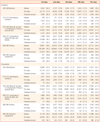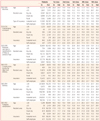Abstract
Objective
This study was conducted to compare the trend of obstetrical care service and its performance, different kinds of common obstetrical disease, and different pattern of health care utilization by the classification of income among the National Health Insurance Beneficiaries.
Methods
This study was investigated on the base of data which were drawn from the "nationwide claim database of Korean National Health Insurance Corporation". Data were composed of the total cases related to pregnancy, childbirth, and the puerperium from 2004 to 2008. Subjects were divided into five income classes by the amount of medical insurance premium. Statistical analysis was performed using SAS program.
Results
In terms of the lowest income class, there was the lowest rate of admission but the highest rate of outpatient visits, which were remarkably increased during the last 2 years. The lowest income group showed higher rate of abortion (O00-O08), ectopic pregnancy and preeclampsia (O10-O16) but there was small number of delivery (O80-O84). The highest income group showed higher rate of multifetal gestation and elderly gravida. As they have higher income, they showed tendency to visit general hospital for admission care or outpatient care.
Conclusion
There were significant differences in obstetric services utilization and prevalence of common obstetrical disease according to income class. New strategy of public medical insurance is needed to support different disease category according to the socioeconomic status. Especially, institutional support should be considered for lower income women who are exposed to higher pregnancy complications.
Figures and Tables
References
1. Stastics Korea. Birth stastics 2010 [Internet]. 2012. cited 2012 May 1. Daejeon: Korea National Statistical Office;Avilable from: http://www.index.go.kr/egams/stts/jsp/potal/stts/PO_STTS_IdxMain.jsp?idx_cd=1428.
2. Kim KH, Hwang RI, Yoon JW, Kim JS. Prenatal care utilization and expenditure among pregnant women. Korean J Health Policy Adm. 2009. 19:53–65.
3. Song YW, Shin JH, Yoon YS, Jeong HC, Yim HE, Choi BM, et al. Preinatal complication of mothers and neonates resulting from inadequate prenatal care. Korean J Perinatol. 2010. 21:347–355.
4. Huh SI. Changes in the financial burden of health expenditures by income level. Health Welf Policy Forum. 2009. 149:48–62.
5. Hwang RI, Lee HY, Kim JH. The comparative analysis for outpatients service utilization by income level among children under 6 years. 2007. Seoul: Health Insurance Forum;110–128.
6. Park JE, Lee HJ. Study on maternal health care and social support for low income women. Korea Womens Dev Inst. 2000. 58:173–187.
7. Heaman MI, Green CG, Newburn-Cook CV, Elliott LJ, Helewa ME. Social inequalities in use of prenatal care in Manitoba. J Obstet Gynaecol Can. 2007. 29:806–816.
8. Dhar RS, Nagpal J, Sinha S, Bhargava VL, Sachdeva A, Bhartia A. Direct cost of maternity-care services in South Delhi: a community survey. J Health Popul Nutr. 2009. 27:368–378.
9. Skordis-Worrall J, Pace N, Bapat U, Das S, More NS, Joshi W, et al. Maternal and neonatal health expenditure in Mumbai slums (India): a cross sectional study. BMC Public Health. 2011. 11:150.
10. Storeng KT, Baggaley RF, Ganaba R, Ouattara F, Akoum MS, Filippi V. Paying the price: the cost and consequences of emergency obstetric care in Burkina Faso. Soc Sci Med. 2008. 66:545–557.
11. Hwang NM. Future directions of maternal and child health policy for healthy start in life. Health Welf Policy Forum. 2008. 141:5–19.
12. Jung HE, Jin MR. The intention of having a second child by the employment status of married women. Korea J Popul Stud. 2008. 31:151–168.
13. Shin Y. An analysis of the effect of burden of childcare and education on childbirth. Health Soc Sci. 2008. 28:103–134.
14. Weitzman BC, Berry CA. Health status and health care utilization among New York City home attendants: an illustration of the needs of working poor, immigrant women. Women Health. 1992. 19:87–105.
15. Kim TE, Lee SP, Park JM, Whang BC, Kim SY. The effects of maternal age on outcome of pregnancy in healthy elderly primipara. Korean J Perinatol. 2009. 20:146–152.
16. Bener A, Saleh NM, Al-Hamaq A. Prevalence of gestational diabetes and associated maternal and neonatal complications in a fast-developing community: global comparisons. Int J Womens Health. 2011. 3:367–373.
17. Duley L. The global impact of pre-eclampsia and eclampsia. Semin Perinatol. 2009. 33:130–137.
18. Song DY. Mental health service utilization and social support for low-income pregnant and postpartum women: a case study on medicaid mothers in America. Korean J Womens Health. 2001. 2:121–149.
19. Kim JS. A sociological analysis of the utilization behavior of general hospital in an urban community. Ewha J Soc Sci. 2000. 4:59–83.




 PDF
PDF ePub
ePub Citation
Citation Print
Print







 XML Download
XML Download